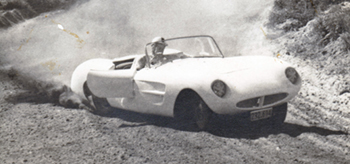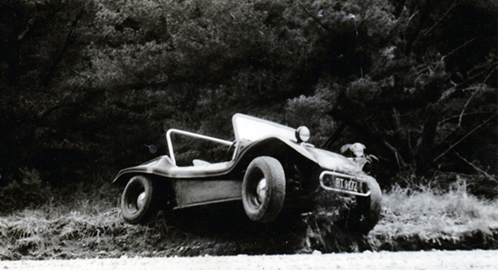The beginning of a New Zealand marque
by Patrick Harlow

Ross racing the Mistral at the 1960 Taupo hill climb and below at the 1961 Tarawera Hill Climb. Note, no roll bar and open door. The door popped open due to chassis twist. 
|
Ross Baker has been designing and building Herons since he left school in the late ‘50s. His first build project began when he purchased his first kit set car way back in 1960. The car Ross chose ‘to cut his teeth on’ was the Mistral. This car had been originally manufactured by Emslie and Flockton in Christchurch. To the young Ross Baker, the Mistral was the most exotic looking sports car on the planet. When compared with the tall boxy cars of that era, it was ahead of its time in both looks and function mainly due to its low centre of gravity. The finished car was carpeted and had well-padded seats. The body was painted white originally but by the time it was sold this had been changed to grey and white in the style of the, then current, Austin-Healey.It became his weekday driver and his weekend racing car. This is when the lifetime friendship with Ross and Bob Gee began. Ross liked to hang the tail out in corners, so much so that it was not unusual for him to hit the banks and damage the rear bodywork. After a race, Bob would berate Ross about the fact that he was supposed to drive the car around corners not through them, before putting his fibre-glassing skills to work repairing the damage. |
|
In 1963 Ross decided to build his second kit car, a Sand Pacer Beach Buggy.Well, everybody else was doing it in the early ‘60s and it looked like it could be a lot of fun. Bruce Meyers designed a fibreglass body for the shortened VW plan that was inspired by a car that he had seen in a Mickey Mouse cartoon. This body changed as many people took note of his car and followed suit with their own interpretation of it. It was called a Dune Buggy in the US but a Beach Buggy just about everywhere else. Many different versions of this car were produced in this country with the Daytona and the Sand Pacer being two of the more well-known ones. Although they were visually different, they followed the same principle of a lightweight fibreglass body that bolted onto a shortened VW floorpan. Thinking it would be a relatively simple project, a VW 1200 chassis was acquired and shortened by Ross to be used in one of the first Sand Pacer bodies to come out of the moulds in Auckland. The finished buggy was used as the shop run-about during the day and for fun on the beaches during the weekends. With the engine over the back wheels and big tyres, it had traction to spare. Ross and his friends even drove it to the top of Mt Tarawera a couple of times before it was closed off to the public. Ross said, “It was amazing where this buggy would take you if you were game enough to drive it.” Occasionally it had to be dug out but that was part of the fun. Ross kept it for about four or five years and then sold it to a client. Right: 1963 Sand Pacer Beach Buggy. Ross is steering with his wife Bev pushing on the left and Donna Ford pushing on the right. As Ross said, “Behind every successful man is a good woman – or two!” circa 1963 |

Above: Bottomed out in the Rotorua forests. circa 1963 
|









